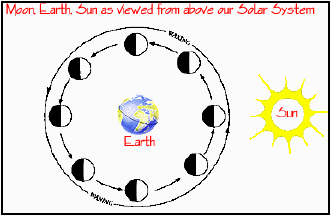
 |
Moon Glow |
This activity can be used in conjunction with StarChild Solar System Level 2 information
OBJECTIVES:
1. Identify the Earth-Moon relationship
2. Identify the phases of the Moon
3. Identify the Earth-Moon-Sun alignment that results in solar and lunar eclipses
MATERIALS:
• Lamp with at least a 60 watt bulb
• Large orange
• One volunteer

Procedure:
As Earth's only natural satellite, the Moon has long been an object of fascination and confusion. Over the course of a 29-day cycle, the Moon shows us many different "faces". These different "faces" are called phases and they are the result of the way the Sun lights the Moon's surface as the Moon orbits Earth. The Moon can only be seen as a result of the Sun's light reflecting off it. It does not produce any light of its own. This demonstration will illustrate why the Moon has so many different looks within that 29-day period known as the lunar cycle. Prior to or after the demonstration, allow the students to go on-line and read additional background information related to the Moon (Solar System section) and man's exploration of this satellite (Space Stuff section).
The following demonstration can be useful to help the students visualize the situation.
1. Put the lamp in the middle of the room. After the lamp has been turned on, darken all other lights. The lamp represents the Sun while the orange represents the Moon and the volunteer represents the Earth. Only the volunteer can see the intended results of this demonstration, so each student will have to take their turn in order to understand the phases of the Moon.
2. Earth will face the Sun holding the Moon in the left hand. The Moon should be held in front at arm's length and slightly elevated overhead. (Make sure the students understand that it is because of the Moon's slightly inclined orbit around Earth that we usually see a full Moon when the Earth is between the Sun and Moon.)
3. Notice that the lamp has lit up the side of the Moon away from Earth. No one on Earth can see the lit side at this point. This is a new Moon and it occurs when the Moon is between the Sun and Earth.
4. While Earth is still facing toward the Sun, hold the left arm straight out to the side. People on Earth will now be able to see half of the Moon's lit side. Because the Moon has now revolved one-quarter of the way around Earth, this phase is referred to as a first-quarter Moon. A first-quarter Moon occurs approximately one week after a new Moon. Have the students carefully notice which half of the Moon is lit during a first-quarter Moon.
5. For the next phase, Earth's back should be to the Sun. The Moon should held out straight in front of Earth, still slightly elevated. Earth can now see the full lit face of the Moon. This phase is a full Moon. The Moon has now completed half of its revolution around Earth.
6. Before moving Earth into the next position place the Moon in the right hand. Now Earth should move the right arm into a position straight out to the side. Once again only half of the Moon is lit. Have the students carefully note which half is lit. This is the phase known as a third-quarter Moon. The Moon has now completed three-quarters of its revolution around Earth. This "face" appears approximately three weeks after a new Moon.
7. To complete the demonstration, have Earth once again face the Sun. The Moon should be held straight out in front of Earth, again showing the darkened side facing Earth. The lunar cycle now starts over again. The demonstration has concluded.
EXTENSIONS:
(1) The intermediate phases of the Moon may also be illustrated with this demonstration. A waxing crescent will occur between a new Moon and a first-quarter Moon. A waxing gibbous occurs between the first-quarter Moon and full Moon. A waning gibbous occurs between a full Moon and a third-quarter Moon. A waning crescent appears between a third-quarter Moon and a new Moon.
(2) To illustrate a lunar eclipse while demonstrating the full Moon phases, allow the arm holding the Moon to drop so that the Moon is now in the Earth's shadow. Lunar eclipses occur on an average of twice a year.
(3) To illustrate a solar eclipse, allow the arm holding the Moon to drop while demonstrating a new Moon. A shadow should fall across a part of the Earth. Explain to the students that people living on the part of the Earth that is in the shadow will experience a solar eclipse. Solar eclipses are less frequent than lunar eclipses. A solar eclipse occurs on an average of once every 18 months.
(4) As a follow-up activity, the students may go on-line and complete Moonlight Madness in StarChild. This activity is located in Level 2 of the Solar System section.